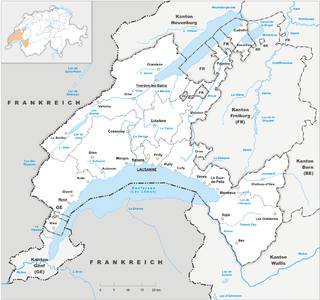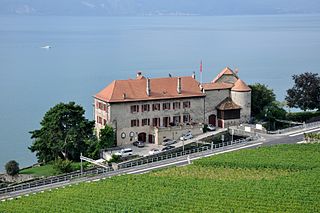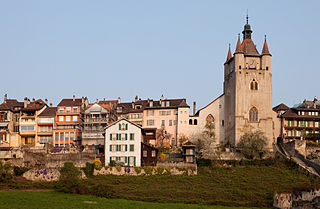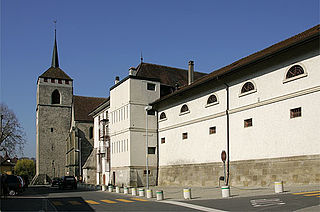
Lausanne is the capital and largest city of the Swiss French-speaking canton of Vaud. It is a hilly city situated on the shores of Lac Léman, about halfway between the Jura Mountains and the Alps, and facing the French town of Évian-les-Bains across the lake. Lausanne is located 62 kilometres northeast of Geneva, the nearest major city.

The four national languages of Switzerland are German, French, Italian, and Romansh. German, French, and Italian maintain equal status as official languages at the national level within the Federal Administration of the Swiss Confederation, while Romansh is used in dealings with people who speak it. Latin is occasionally used in some formal contexts, particularly to denote the country.

Vaud, more formally the Canton of Vaud, is one of the 26 cantons forming the Swiss Confederation. It is composed of ten districts; its capital city is Lausanne. Its coat of arms bears the motto "Liberté et patrie" on a white-green bicolour.

Chillon Castle is an island medieval castle located on Lake Geneva, south of Veytaux in the canton of Vaud. It is situated at the eastern end of the lake, on the narrow shore between Montreux and Villeneuve, which gives access to the Alpine valley of the Rhône. Chillon is amongst the most visited medieval castles in Switzerland and Europe. Successively occupied by the House of Savoy, then by the Bernese from 1536 until 1798, it now belongs to the canton de Vaud and is classified as a Swiss Cultural Property of National Significance.

Romandy is the French-speaking historical and cultural region of Switzerland. In 2020, about 2 million people, or 22.8% of the Swiss population, lived in Romandy. The majority of the romand population lives in the western part of the country, especially the Arc Lémanique region along Lake Geneva, connecting Geneva, Vaud, and the Lower Valais.
With 84 lodges and 3’350 members, the Grand Lodge Alpina of Switzerland (GLAS) is a Swiss Masonic obedience founded in 1844.

Palais de Beaulieu is the historical and emblematic building of the Lausanne convention and exhibition center, located in Lausanne, in the Vaud Canton, Switzerland. The Palais is a convention centre that welcomes mainly conventions and events.

The Western Switzerland Railways, were initially a joint operation of three Swiss railway companies, but these companies merged on 1 January 1872. The company was called the Western Switzerland–Simplon Railways from 28 June 1881. The SOS merged with the Bernese Jura Railways to form the Jura–Simplon Railways on 1 January 1890.

Château Saint-Maire is a castle in Lausanne, Switzerland, that serves as the seat of the cantonal government, the Council of State of Vaud. It is a Swiss heritage site of national significance.

The Palais de Rumine is a late 19th-century building in Florentine Renaissance style in Lausanne, Switzerland.

Vallorbe railway station is a station at the border of Switzerland and France on the TGV Lyria line between Paris and Lausanne. It is located at the south-eastern entrance of the tunnel which tunnels one of Jura's mountain ranges, Le Mont d’Or. The station serves the municipality of Vallorbe, in the Canton of Vaud, Switzerland.

The Cinémathèque suisse, formerly the Archives cinématographiques suisses, is a Swiss state-approved non-profit foundation headquartered in Lausanne. It aims to collect, protect, study and present film archives. The Swiss Cinematheque has its archives in Penthaz and a branch office in Zürich.

The Lausanne campus or Dorigny university campus is a large area in Switzerland where the University of Lausanne (UNIL), the École polytechnique fédérale de Lausanne (EPFL) and several other institutions are located. It is in Dorigny, towards the west of Lausanne, on the shores of Lake Geneva. The site is about 2.2 kilometres wide and 31,000 people study and work there.
Scriptorium is the digital library of the Cantonal and University Library of Lausanne, part of the University of Lausanne in the Swiss canton of Vaud. It was launched on 7 December 2012 and initially included more than a million pages of digitized newspapers published in Vaud canton.

Glérolles Castle is situated in the municipality of Saint-Saphorin, canton of Vaud, Switzerland, on the northern shore of Lake Geneva. Its earliest elements date from a fortress built around 1150. The modern building serves as the headquarters for a vineyard of the same name, and as a venue which can be hired to host social events. It is a Swiss Cultural Property of Regional Significance.

The Swiss Reformed Church of Saint-Maurice, also named Church of Saint Marcel or simply the Chavornay Temple, is a Protestant church in the municipality of Chavornay, Vaud, Switzerland. It is a parish church of the Evangelical Reformed Church of the Canton of Vaud. It was listed as a heritage site of national significance.

Orbe Temple, also known as the Reformed Church of Notre-Dame or the Great Church of Orbe, is a Protestant church in the municipality of Orbe, canton of Vaud, Switzerland. It is a parish church of the Evangelical Reformed Church of the Canton of Vaud. It is listed as a heritage site of national significance.
The Saint-Saphorin Roman Villa was a Roman villa in the village of Saint-Saphorin in the Lavaux region, canton of Vaud, Switzerland. It is listed as a heritage site of national significance alongside the Reformed Church of Saint-Symphorien and the neighbouring vicarage.

The Reformed Church of Saint-Étienne, also known as the Temple of Saint-Étienne, is a Protestant church located in the municipality of Moudon, canton of Vaud, Switzerland. It is a parish church of the Evangelical Reformed Church of the Canton of Vaud. It is listed as a heritage site of national significance.

Le Day railway station is a railway station in the municipality of Vallorbe, in the Swiss canton of Vaud. It sits at the junction of the standard gauge Simplon line of Swiss Federal Railways and Vallorbe–Le Brassus line of SBB and Travys.


















